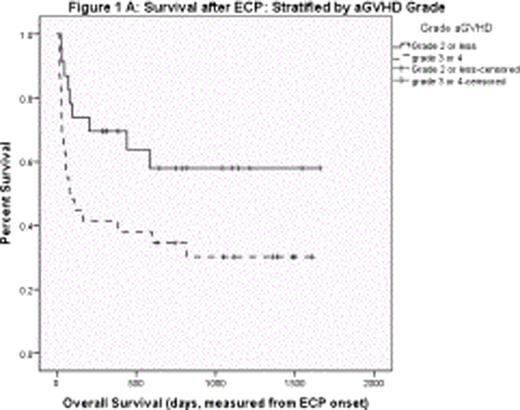Abstract
Abstract 1973
Outcome of patients with steroid refractory acute GVHD (aGVHD) remains poor and the optimal therapy remains ill-defined. ECP has been successfully used for treating steroid-resistant chronic GVHD. We studied the efficacy and outcome of ECP used as salvage therapy in patients with steroid refractory/dependent aGVHD at 2 centers: Vanderbilt University, USA and Nottingham, UK. Methods: Transplant and aGVHD characteristics of patients treated with ECP from 1/2006 to 8/2010 were reviewed. Steroid doses at onset and completion of ECP were available. Steroid refractory aGVHD was defined as progression after 3 days or no response after 7 days of systemic steroids. Steroid dependent aGVHD was defined as recurrence of aGVHD during steroid taper. Responses to ECP were abstracted from medical records and were determined at completion of ECP. Patients were transplanted for hematological malignancies on standard of care or IRB approved protocols. Results: Fifty two patients (Vanderbilt-29; Nottingham-23) were treated with ECP for steroid dependent (15, 29%) or steroid refractory (32, 63%) aGVHD at a median of 59 days (range, 12–99) after transplant. Indication for ECP was missing for 5 patients. aGVHD was seen after first transplant (44, 85%), second transplant (1, 2%) or after donor lymphocyte infusion (7, 13%), respectively. Grade 3–4 aGVHD was present at onset in 29 (57%) patients. Stage 3–4 skin, GI, and liver involvement occurred in 28 (37%), 15 (29%) and 9 (18%) patients, with three organ involvement at onset in 9 (17%) patients. All patients received systemic steroids prior to ECP for a median of 18 days (range, 10–91). Initial therapy consisted of 1 mg/kg or 2 mg/kg prednisone equivalent in 24 (46%) and 26 (50%) patients, respectively. Forty-one patients (79%) had either no or partial response after 7 days of steroid. ECP was administered as 2 treatments per week on a weekly to bi-weekly frequency and then stopped or tapered depending on response. Steroids were tapered at the discretion of the treating physician. Median number of ECP treatments was 12 (range, 2–45) given over a median duration of 55 days. Thirty-two (63%) patients responded to ECP (CR-26, 50%; PR-6, 12%). At the end of ECP treatment, grade 3–4 aGVHD was present in 17 patients (33%) with stage 3–4 involvement in skin (4, 8%), GI (10, 20%) and liver (10, 20%), respectively. The median steroid dose at termination of ECP in ECP-responders and non-responders was 0.15 mg/kg (range, 0–0.75) and 2 mg/kg (range, 0.15–2.3), respectively (P<0.001). ECP response: Donor type, stem cell source, aGVHD grade at onset, and organ –specific stage did not impact response. ECP response was superior for aGVHD developing after ablative regimen compared with reduced intensity/non-ablative regimens (76% vs. 48%, P=0.05). Patients with response at day 7 after initial steroid and subsequent steroid dependent aGVHD had a better response with ECP (80% vs. 50%, P=0.042). In logistic regression analyses, adjusted for regimen intensity, response at day 7 of initial steroid showed a trend for predicting ECP response (OR=4.22, 95% CI 0.95–18.7, P=0.058). Survival: Of the 52 patients, 28 (54%) are deceased (GVHD-19, relapse/progression-5, infections-4). The median follow up of the cohort after onset of ECP is 309 days (range, 12–1657). Median and 2-yr overall survival (measured from onset of ECP) is 442 days (95% CI, 0–993) and 42%. In univariate analyses, median survival after ECP onset was superior for patients who had an ablative transplant (not reached vs. 44 days, P=0.05), and had grade 2 or less aGVHD at onset (not reached vs. 79 days, P=0.028) (Fig. 1A). Indication of ECP (steroid dependent or refractory) did not impact survival. Patients with ECP response had a superior survival (measured from end of ECP) compared to non-responders (median survival, not reached vs. 14 days, P<0.001) (Fig. 1B) with a 65% 2-yr survival in ECP responders. In Cox proportional analyses, response to ECP was an independent predictor of survival (HR 0.091, 95% CI 0.034–0.263, P<0.001), after adjusting for regimen intensity and grade of aGVHD at onset. Conclusion: ECP is an effective steroid-sparing salvage therapy for patients with steroid dependent or refractory aGVHD with a response rate of 63% and 2-yr survival of 65% in responders. Based on this data, it is reasonable to undertake a prospective randomized study of ECP versus other agents, in patients with steroid dependent or refractory aGVHD.
No relevant conflicts of interest to declare.
Author notes
Asterisk with author names denotes non-ASH members.



This feature is available to Subscribers Only
Sign In or Create an Account Close Modal